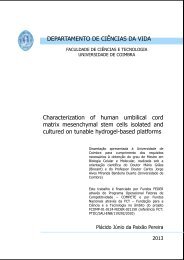role of th1 and th17 cd4+ t cell subsets in the pathogenesis of ...
role of th1 and th17 cd4+ t cell subsets in the pathogenesis of ...
role of th1 and th17 cd4+ t cell subsets in the pathogenesis of ...
Create successful ePaper yourself
Turn your PDF publications into a flip-book with our unique Google optimized e-Paper software.
<strong>in</strong>flammatory cytok<strong>in</strong>es <strong>and</strong> <strong>cell</strong>ular debris after <strong>in</strong>jury or necrosis. In vitro studies have<br />
shown that microglia are able to secrete a panel <strong>of</strong> <strong>in</strong>flammatory cytok<strong>in</strong>es <strong>and</strong><br />
chemok<strong>in</strong>es such as IL‐6, macrophage <strong>in</strong>flammatory prote<strong>in</strong>‐2 (MIP‐2), nitric oxide,<br />
adhesion molecules, <strong>and</strong> neurotrophic factors <strong>in</strong> response to IL‐17. Additionally, <strong>the</strong>se<br />
<strong>cell</strong>s can also be an <strong>in</strong>nate source <strong>of</strong> IL‐17 <strong>in</strong> response to IL‐23 or IL‐1β, contribut<strong>in</strong>g<br />
<strong>the</strong>refore to <strong>in</strong>flammation <strong>in</strong> autoimmune diseases such as MS (Kawanokuchi et al.,<br />
2008).<br />
30<br />
1.4 ‐ THE PARADIGMS OF HELPER T CELL SUBSETS: MORE COMPLEX<br />
THAN INITIALLY THOUGHT<br />
There are several <strong>subsets</strong> <strong>of</strong> effector helper CD4 + T <strong>cell</strong>s. Depend<strong>in</strong>g on <strong>the</strong><br />
microenvironment <strong>and</strong> cytok<strong>in</strong>es released by <strong>the</strong> APCs, a naïve T <strong>cell</strong> responds to<br />
presentation <strong>of</strong> <strong>the</strong> cognate antigen, <strong>in</strong> <strong>the</strong> context <strong>of</strong> <strong>the</strong> major histocompatibility<br />
complex (MHC) class II, by differentiat<strong>in</strong>g to different helper T <strong>cell</strong> <strong>subsets</strong>. In 1986,<br />
helper T <strong>cell</strong>s were classified for <strong>the</strong> first time <strong>in</strong>to two <strong>subsets</strong>, type 1 helper T <strong>cell</strong>s<br />
(Th1) <strong>and</strong> type 2 helper T <strong>cell</strong>s (Th2), based <strong>in</strong> <strong>the</strong>ir cytok<strong>in</strong>e production (Mosmann et<br />
al., 1986). Th1 <strong>cell</strong>s produce high amounts <strong>of</strong> <strong>in</strong>terferon gamma (IFNγ) whereas Th2<br />
<strong>cell</strong>s produce <strong>in</strong>terleuk<strong>in</strong>‐4 (IL‐4), IL‐5 <strong>and</strong> IL‐13. The Th1/Th2 paradigm associated <strong>the</strong>se<br />
T <strong>cell</strong> populations with specific immune responses. While Th1 <strong>cell</strong>s are specialized <strong>in</strong><br />
macrophage activation <strong>and</strong> defense aga<strong>in</strong>st <strong>in</strong>tra<strong>cell</strong>ular pathogens, <strong>in</strong>clud<strong>in</strong>g viruses<br />
<strong>and</strong> some bacteria such as mycobateria, Th2 <strong>cell</strong>s, <strong>in</strong> contrast, are particularly<br />
important for defense aga<strong>in</strong>st large extra<strong>cell</strong>ular pathogens such as helm<strong>in</strong>ths, for <strong>the</strong><br />
<strong>in</strong>duction <strong>of</strong> immunoglobul<strong>in</strong> E (IgE) by B <strong>cell</strong>s, mast <strong>cell</strong>s activation <strong>and</strong> eos<strong>in</strong>ophils<br />
mobilization. Allergic diseases are characterized ma<strong>in</strong>ly by a Th2 response, whilst<br />
autoimmune diseases are driven by Th1 <strong>cell</strong>s. However, this paradigm soon proved to<br />
be too simplistic as many observations from cl<strong>in</strong>ical diseases could not be expla<strong>in</strong>ed by<br />
this simple categorization. More recently, several <strong>subsets</strong> <strong>of</strong> Tregs capable <strong>of</strong><br />
controll<strong>in</strong>g effector T <strong>cell</strong>s responses were described: <strong>the</strong> thymus derived nTregs, <strong>and</strong><br />
<strong>the</strong> iTregs, Tr1 <strong>and</strong> Th3 regulatory T <strong>cell</strong>s derived from peripheral helper T <strong>cell</strong><br />
precursors. Fur<strong>the</strong>rmore, <strong>in</strong> 2005 Dan Cua <strong>and</strong> colleagues described a new pathogenic<br />
CD4 + T <strong>cell</strong> population that is driven by IL‐23, produces IL‐17, IL‐17F, IL‐6, <strong>and</strong> tumor

















